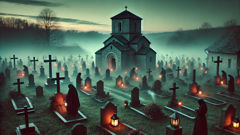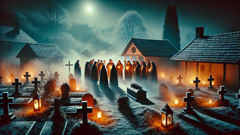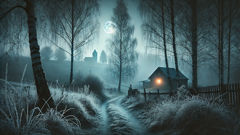Introduction
By the time the moon drew itself thin above the ridge, the village had settled into the brittle hush of winter sleep. Smoke bowed low from chimney mouths, and the river—black and narrow—moved as if it were carrying muffled things away. On such nights men with strong hands and women with worn faces would press shutters closed and pull shawls over their ears, not because some tyrant prowled, but because of a cry that had no business in the world of the living. They called it the Drekavac: the screamer, the thing that mourned. Parents told children to stay under blankets, priests muttered the names of saints, and midwives kept vigil over fires. The Drekavac was not a story printed in a book to be placed on a shelf; it was a sound that could twist stomachs and break biddings between neighbors. In the lowlands around the old churchyard and the patches of birch that separated fields, the legend of the Drekavac threaded the village’s memory—an uneasy knot that had been tugged at by famine, fever, and the blows of war for generations. This tale traces the whispers of those nights, the customs meant to hold the restless, and one winter when the boundary between ritual and sorrow thinned so much that a single lantern could not tell where mercy ended and fear began.
Origins of a Cry: How the Drekavac Became Part of the Night
Across the rolling hills and shadowed riverbanks of Serbia, the Drekavac existed long before anyone thought to pen it down. Oral memory was the village's slow, patient archive: a crooked string of episodes repeated by hearthsides, shaped by the breath and caution of those who'd faced hunger and hard winters. To understand the Drekavac is to understand how communities name what they cannot hold. In years when infant mortality climbed like a black vine through households, when sickness and war stole names before baptism could mark a soul, people needed language for the ache left behind. The Drekavac answered that need. Its form shifted with each telling—sometimes a spindly child whose limbs were too long for the cradle, sometimes a wailing shadow skirting the reedbeds, sometimes a voice that imitated a mother's lament and lured the living out of their doors. But the constant was always the sound: a scream or stuttering cry that arrived at midnight or when the fog lay low, rising thin and then fracturing into the night as though torn by racks no human shoulders could bear.

Folklorists, when they later gathered fragments, found overlapping layers: an older pre-Christian notion of restless spirits, the Christian anxieties surrounding baptism and proper rites, and local superstition braided into agricultural caution. In a farming hamlet the Drekavac's cry could mean more than the supernatural; it punctured the collective fear that without rites, a disrupted family line might attract misfortune or unsettle crops. Thus ritual and rumor reinforced one another. Midwives and elder women built an entire repertoire of do's and don'ts: wrap the newborn tightly, speak the God-forbidden names softly, and if a baby died before baptism, bury it at dawn or place certain tokens with the body. The rationale blended theology with practicality. A baptized child, it was said, belonged to the saints and could move toward mercy; an unbaptized child, its fate unmarked in the church's ledger, might return as a Drekavac to demand what the world had not given.
The Drekavac's particulars differed from one valley to the next. In some tellings, its cry foretold death elsewhere: a neighbor's cow gone to rot in a field, a well poisoned overnight, or a soldier taken in the next day's skirmish. In others, the spirit was petty and cunning, seeking to bring mischief or to be bribed with tokens—bread, a candle, a red thread tied to the cemetery fence. Women who had seen the Drekavac described an odd, piercing scent, like riverweed and iron, and the way the air around lanterns seemed to thicken. More than a few recounted meetings that blurred the line between nightmare and waking memory: a small, wet hand upon a sleeve in the dark; a lullaby half-remembered that stopped when the light came. Such details made the Drekavac an intimate terror; it was not a distant monster but a presence that could touch a sleeve or settle above a child's cradle.
The church complicated the tale. Priests preached that baptism and prayer kept souls aligned with heaven, and thus the Drekavac could be read as a theological warning about the dangers of neglecting sacraments. Yet the church's reach was irregular—seasonal roads, distant parishes, and times of conflict meant midwives and villagers sometimes held the responsibility alone. In those spaces informal rituals spread. Salt, an old coin, and the cross were placed with the deceased; hens were spared for a night to cluck over the grave; women sang hush-songs and carried the infant on a belt through three circles around the home. These practices created a lattice of meaning around birth and death, and when any node in that lattice failed—a route blocked by snow, a priest killed in an uprising, a midwife lost to fever—the Drekavac’s cry arrived to remind the living of the thin places between their customs and the unknown.
Beyond practical fears, the legend served a psychological role. When a child's life ended suddenly, or a family could not perform the correct ceremony, the Drekavac crystallized communal guilt. The villagers could point to it as explanation and cautionary tale. And stories traveled: seasonal fairs, soldiers' talk along trade roads, and travelers returning with new versions that added horns, eyes, or the ability to mimic voices. The Drekavac evolved because people needed it to, because human grief and superstition are not static things. The old told the young: if you hear the cry, do not follow it. If you find a small body in the reeds, do not touch it with bare hands. If the wail calls like your own child's voice, light a candle and go to the church at dawn. Those admonitions were not mere superstition; they were a way of shaping behavior so that fear, ritual, and practical care together kept families as whole as they could be in an unforgiving land.
This layering of belief allowed the Drekavac to remain both threat and teacher. Over the years it became a moral instrument: a tale parents used to keep children close at night, a sermon illustration for priests, and a lament in folk songs. But for all its utility, villagers told different stories about how to quiet the cry. Some claimed that finding the proper grave and placing a white cloth over it would silence the spirit; others swore only a sincere act of charity—feeding a beggar, donating seed to the church—would satisfy the restless. There was no single answer, only practices that worked sometimes and failed others. The ambiguity persisted because the Drekavac was itself ambiguous: part sorrow, part warning, and part thing that sprang from a world where death and rites tangled. It lived in the pauses between prayer and silence and in the places where roads to the church were unsafe or too long.
As memory advanced toward modernity, government records and ecclesiastical notations occasionally referenced such spirits, often in terms phrased to assimilate folk belief into doctrine. Yet the Drekavac never fully surrendered to the pages of official accounting. It remained an oral presence: a howl in the reedbeds, a baby's cry in the fog, and the echo of old rules in a time when the village relied on one another to survive. It is in that liminal place between the ritualized control of death and the rawness of loss that the Drekavac took its enduring power. The villagers’ attempts to name and bind the cry taught them what they valued—community, rites, and the fragile etiquette of grief—and it is those efforts, rather than the scream itself, that held the story together.
Even so, story and night are not mere abstractions. The Drekavac demanded a face in the dark, an encounter that tested the weave of customs. It was into such a night that our next chapter slips, when a single winter brought the village to the edge of its rituals and made clear that some songs meant to close wounds were themselves fragile.
Night of the Lantern: One Village's Reckoning
The winter that truly tested the village came after a summer of bad harvest and news of conscription. Men left for service in the north, and those who remained bartered firewood with gold that had been earned during better years. The river carried rumors of a fever moving from hamlet to hamlet; the midwife, Katarina, had lost a sister to it and felt the ache of a community stretching thin. It was on a night when the wind turned south and rain began to bead on windowpanes that the Drekavac's cry first threaded through the hamlet in a pattern more urgent than anyone had yet heard. It was not the wandering, distant cry that could be shrugged off at a distance; it was layered, close, and it answered itself—first like a child's wail, then like a chorus of small voices, and finally like a single scream that stopped the breath of anyone who heard it.

Neighbors gathered as they always did at the window frames, but that night their whispers turned to fear. Old Mladen, who had buried five sons, swore the sound was the same one he'd heard after the fever of '47. The priest lifted his lantern and muttered something about unbaptized souls and the need to check the eastern graveyard. Katarina, who had helped more births than anyone alive and held the village's knowledge of rites in a worn chest in her cottage, felt a weight in her chest that was not just fear. She remembered times when roads were blocked by snow for a week, and the priest could not reach a child in labor. She remembered the last time a family could not afford a bell-ringer and the hush that followed. The memory of things left undone made her step outside.
The lane smelled of wet earth and the metallic tang some associated with the Drekavac. Lanterns bobbed like frightened stars as men and women made for the eastern graveyard, a place where peat bogs met scrub and old oaks leaned like watchful elders. When they arrived, the ground had patches of frost and a faint track of small feet leading toward the reeds; the air vibrated as though carryings had just passed. There, half buried in snow and mud, lay a tiny body swaddled in linen that had once been white. Katarina's hands trembled as she lifted it, not because the body was unfamiliar—babies died, and they always had—but because no coin or cloth of baptism rested around the neck. The child had died before the sacrament could mark it, and the village felt the tug of custom like an ache.
The question that follows such findings has always been the same: what do you do when rites go unfinished? Some at the grave argued for a quick ceremony by the roadside; others demanded the priest be called at dawn. Old Mladen insisted on a votive candle and a sack of grain to feed the church; a young man named Jovan proposed sealing the grave with iron nails driven around the edges. Katarina, with the steadiness of someone who had seen too many last breaths, told them the truth that did not satisfy anyone: a ritual matters less than the sincerity of those who perform it. ‘‘If we stitch the act with the thread of our honest grief and our shared care,’’ she said, ‘‘the child may find ease.’’ Her words were met with a mixture of relief and resentment. For some of the villagers, admitting the failure of schedules and reach was like admitting weakness.
They chose a middle path. The priest—who had lost a brother to the war and whose voice was thin from wear—agreed to a brief, improvised rite by the grave. Lanterns were set in a semicircle, and people placed their offerings: a cross of stitched cloth, a scrap of bread, a coin. Katarina wrapped the child's hands in a red thread, as her mother had taught her, and pressed it to her lips. The words spoken were a tumble of prayer and folk formulae, a hybrid of church liturgy and older invocations. They sang a hymn and then a lullaby that seemed to come from the land itself; the song traced the child's life in imagined moments—the first breath, the first hunger, the first warmth.
As the singing dwindled, the air shifted. A distant cry answered them—thin, unsure—and then silence. For a moment the villagers felt their chests unclench. But the Drekavac's history had taught them not to trust a single night. Months of uneasy peace followed; the cries returned sometimes and vanished other times, snatched at by the wind. Some nights the child’s voice seemed soothed, other nights it was ravenous. Rumors sprang up: parents claimed to have seen little lights over certain graves; a shepherd swore a child’s presence followed his flock; a widow found her cross turned face down. The village grew more watchful, but also more compassionate. The shared work of making offerings and watching graves drew them closer. They repaired old bridges so the priest could reach the more remote fields quicker, they organized bell-ringing rotations when a winter storm threatened to keep the priest away, and they kept small boxes of wine and bread ready in case a family could not afford to travel. The Drekavac, in its wrenching way, pointed to vulnerabilities they had tolerated too long: loneliness, poor roads, and the cost of staying true to rites.
But the story did not end with pragmatic improvements. The Drekavac had a stubborn intelligence in the village’s imagination. It learned to mimic voices as ruined things learn to rebuild; it could sound like a crying infant, a calling mother, or even an old friend asking for help. That capacity made nights perilous. Katarina once stepped out to answer what she thought was her sister’s call and found only a tuft of birch and the echo of a sound that was not a human voice but something shaped out of longing. From then on she carried, secreted inside her apron, a small wooden cross hewn by her father and a scrap of paper folded with a prayer. When the cry came again one frosty evening while she walked the lane home, she did not follow. Instead she sat on the steps of a wayward house and sang a lullaby for herself until the sound in the night died away. She learned that restraint was sometimes the truest rite.
The village continued to live with the Drekavac by bringing the social fabric to the forefront of rituals. They found that when people maintained ties—visited the lonely, ensured christenings and burials were not neglected, and shared grain in times of need—the cry lost much of its sharpness. Sorrow did not vanish, but it softened into remembrance. Stories of the Drekavac shifted from pure terror to tales of duty and love. The spirit, so the villagers concluded, was an echo of what the living had failed to complete: a symbol that demanded not sacrifice, but attention. In that winter the lanterns taught them that light mattered not only to banish the dark where fear hides but to remind neighbors that rituals are public acts of care.
Even so, the Drekavac remained a teacher who never stopped testing the village. New generations heard the tale in slightly different tones: some as a ghost story to make children obedient; others as a moral to encourage communal responsibility. The older ones—those who had stood in the cold by the eastern graveyard and touched the small linen-wrapped body—knew that the Drekavac was also a complaint, a voice raised by a world that had been careless. They buried the child and sang, and yet they understood that burials and prayers are not magic against grief; they are the beginning of a binding. Over time the cries became less frequent, as if the combined work of the villagers anchored some of the restless. But every so often, when a road was washed out or a winter blocked the bells, the Drekavac remembered them, and the mourning returned with the wind.
The night of the lantern, therefore, was not merely an episode of fear; it was a fulcrum. It shifted how the village treated its rituals and one another. Where once custom had been rote and private, it became communal and practical. They realized rituals were not only for the dead but also for the living who must continue. The Drekavac, which had once been a scourge of superstition, became a reminder: that in tending to rites, people tend to one another, and that attention can sometimes, though never always, rearrange the world enough to let a small voice rest.
Conclusion
Legends like that of the Drekavac are never merely fears to be cataloged; they are conversations between the living and their past, a way that communities encode the costs of neglect and the means of repair. The Drekavac asks hard questions: who do we owe rites to, and how do we honor the thin places where the dead linger? In the Serbian hills such a question braided itself into practical action—mending roads, keeping a lantern ready, sharing bread—so that what once threatened to tear a village apart became an instrument to hold it together. The screamer's cry taught vigilance and kindness in equal measure. It taught that ceremonies are less an appeasement of spirits than a public promise: to remember, to reach, and to bind. The Drekavac, then, remains in the memory not only as a haunting of the night but as a mirror of communal responsibility. The sound of its wail still slips through birch and reed on quiet evenings, and the old people who once stood at gravesides know how to move then—tending lanterns, saying a prayer, and, most of all, ensuring that no voice will be left unanswered for lack of care.













